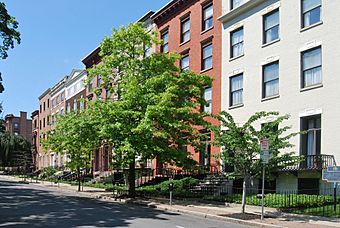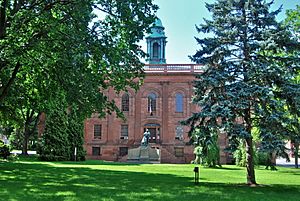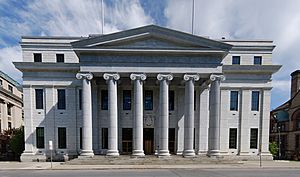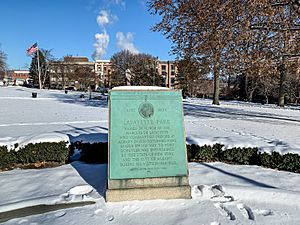Lafayette Park Historic District facts for kids
Quick facts for kids |
|
|
Lafayette Park Historic District
|
|

Elk Street row houses, 2011
|
|
| Location | Albany, NY |
|---|---|
| Area | 36 acres (15 ha; 150,000 m2) |
| NRHP reference No. | 78001837 |
| Added to NRHP | November 15, 1978 |
The Lafayette Park Historic District is a special area in central Albany, New York. It includes a beautiful park and many important buildings. You'll find large government offices and smaller rowhouses on the nearby streets. In 1978, this area was named a historic district. This means it's a place with important history and buildings. It was also added to the National Register of Historic Places (NRHP).
Many buildings here are famous on their own. For example, the New York State Capitol building is a National Historic Landmark. Other big government buildings include City Hall and the home of Albany County government. You can also find the state's highest court and the offices of the New York State Education Department. The Episcopal Diocese of Albany's cathedral is also in this district.
For a long time, the neighborhood was known for its fancy townhouses on Elk Street. Many important people lived there, including governors of New York. Even future presidents Martin Van Buren and Franklin D. Roosevelt called Elk Street home. Two amazing inventions also happened here. The first working electromagnet was created, and the world's first cantilevered arch bridge was built. Even though many old houses are now offices, the district still feels special. The parks have seen many events, from Civil War fundraisers to recent protests.
Contents
Exploring the Lafayette Park Area
The Lafayette Park Historic District covers about 36 acres. It's shaped like a rectangle, stretching north and south of Washington Avenue. The land gently slopes down towards the Hudson River. On the north side, it drops more steeply into an area called Sheridan Hollow.
Much of the southern part of the district is open green space. East and West Capitol parks are on either side of the state capitol building. To the northeast, you'll find Lafayette Park and Academy Park. The old Albany Academy building, now the main offices for the Albany City School District, sits between them.
The big government buildings around the park were mostly built in the late 1800s. They show off different architectural styles. The capitol building mixes Second Empire and French Renaissance styles. The Court of Appeals and Education Department buildings are Classical Revival. The cathedral has a Gothic Revival look. The homes in the northern part are mostly two-story brick townhouses from the late 1800s and early 1900s.
A Look Back in Time: History of the District
The Lafayette Park area has always been important. For most of the 1800s, it was famous for its grand homes. After the current capitol building was finished around 1900, big government buildings started to take over. The parks, including Lafayette Park, were created in the early 1900s.
The 1800s: Homes of Important People
This neighborhood has been a center of power since the early 1800s. In 1809, the first state capitol building in Albany was built next to where the current one stands. The city government also used this building. The Albany Academy building, designed by Philip Hooker, was built between 1815 and 1817. It's the oldest building still standing in the district.
A dozen years later, a professor named Joseph Henry did amazing experiments at the Academy. He proved the idea of inductance and created the first working electromagnet. He showed his students how a magnet could ring a bell from across the room. This was a big step towards inventing the telegraph!
In 1832, Albany built its own City Hall. The next year, Academy Park was officially created. Elk and Columbia streets became popular places to live. Many of the houses on Elk Street were built between 1827 and 1833. They were some of Albany's best Greek Revival homes.
Because it was so close to the capitol, Elk Street was a favorite place for New York's governors to live. Martin Van Buren, who later became a U.S. President, owned a house at 4 Elk Street. His nephew, Henry James, who became a famous writer, visited the house when he was young.
The New York State Court of Appeals Building was designed in 1835 and opened in 1842. It was first called "State Hall" and held other state offices. This neoclassical building was considered one of the best government buildings of its time. After the American Civil War, construction began on the new capitol.
In 1880, the old City Hall burned down. Henry Hobson Richardson, who was working on the state capitol, designed the current building. It was finished quickly. The Episcopal Diocese of Albany's Cathedral of All Saints was completed in 1888. The architect Robert W. Gibson designed it in the Gothic Revival style.
The Hawk Street Viaduct was built in 1888. This 1,000-foot bridge connected the neighborhoods north of Sheridan Hollow to the Lafayette Park area. It was believed to be the world's first cantilevered arch bridge. Today, only a part of its railing and its south support remain.
By 1899, the new state capitol was finally finished. With so much government activity, some of the old houses nearby started to become offices.
The 1900s to Today: New Buildings and Parks
The early 1900s brought big changes. Two more large government buildings were added. In 1906, the first commissioner of the New York State Education Department (SED) wanted a new building for his agency. He chose the block where the Cathedral of All Saints stood. The SED building was designed in the Beaux-Arts style with a long colonnade.
From 1910 to 1912, future president Franklin D. Roosevelt lived at 4 Elk Street while he was a state senator. In 1912, the Education Department building opened. Four years later, Albany County's new courthouse and office building opened next to the Court of Appeals.
Starting in 1908, the area between Academy Park and Hawk Street was cleared to create Lafayette Park. It was named after the Marquis de Lafayette, a French hero who visited Albany. More statues were put up in the new open spaces. A memorial to Union Army General Philip Sheridan was placed east of the capitol. In 1925, a statue of Revolutionary War General Philip Schuyler went up in front of City Hall. Two years later, a statue of Joseph Henry was placed in front of the Albany Academy.
West Capitol Park was made much larger in the 1930s. It was designed to be a grand "court of honor" surrounded by the Capitol and other important buildings. A copy of Jean-Antoine Houdon's statue of George Washington was placed in the park in 1932.
The buildings' uses changed over time. In 1930, the Albany Academy moved out of its old building. The city bought it, and it became the offices for the Albany City School District. Many of the old, fancy homes became offices or apartments.
In the late 1960s, new, modern towers were built to the south, making the older buildings seem small. People started working to protect the historic buildings. In 1969, an old house at 1 Elk Street was torn down. But activists saved the fronts of three townhouses at the corner of Elk and Eagle streets.
In 1970, the Hawk Street viaduct was taken down to build a parking garage. Only a small part of it remains. In the late 1970s, the state library and museum moved out of the SED building into new, larger spaces.
In 1986, a memorial for Albany County's soldiers who died or went missing in the Vietnam War was planned for Lafayette Park. It's a tall stone monument with their names and a soldier's relief. It was put in place in 1992.

In 2011, a group called Occupy Albany set up tents in the parks. They were protesting economic unfairness. The state tried to make them leave, but city officials gave them a permit to stay in Academy Park. Occupy Albany stayed for 15 days before winter arrived. The group still holds events in the parks today.
Important Buildings in the District
Six buildings in the district are so important that they are also listed on the National Register of Historic Places on their own. These include the cathedral and most of the government buildings. One of them, the state capitol, is even a National Historic Landmark!
National Historic Landmark
- New York State Capitol, State Street: This huge building was finished in 1899 after 32 years of construction. It's one of the few state capitol buildings without a dome. The first architect, Thomas Fuller, designed a domed building. But he was removed from the project because it cost too much. Other architects, like Henry Hobson Richardson, finished the building. It's often called "a building at war with itself" because of its mixed styles.
Buildings on the National Register of Historic Places
- Albany City Hall, 24 Eagle Street: Henry Hobson Richardson designed this building in 1880 after the old one burned down. This granite building is considered one of his best works. In 1927, its 202-foot tower got the first city carillon (a set of bells) in America.
- Cathedral of All Saints, 62 South Swan Street: Robert W. Gibson designed this Gothic Revival stone and brick building in 1884. It was finished four years later. The bishop wanted it to be the center of a large church complex. But the SED building was built nearby, making those plans impossible. The cathedral itself is still not fully finished.
- Old Albany Academy Building, Academy Park: Philip Hooker's 1815 stone building is the oldest civic building in Albany. Joseph Henry did his famous electromagnetism experiments here. The building has been home to the Albany City School District since 1930.
- New York Court of Appeals Building, 20 Eagle Street: Built in 1842, this Greek Revival building was first called State Hall. It housed several government offices. Its design features all three main classical orders (Doric, Ionic, Corinthian).
- New York State Education Department Building, 89 Washington Avenue: This huge 1906 Classical Revival stone building was the first in America to house a state's education agency. It has a long colonnade of columns. It also used to house the state library and museum until the 1970s.
Parks and Statues
- Academy Park: This was the first park in the district, created in 1833. It's named after the nearby school. You can find a statue of Joseph Henry here, honoring his discovery of electromagnetism. The city manages this park.
- East Capitol Park: A statue of Civil War general Philip Sheridan, who grew up in Albany, stands here. It's located between Eagle Street and the state capitol building.
- Lafayette Park: This larger park was created in the 1920s. It's named after the Marquis de Lafayette, a French hero who visited Albany.
- West Capitol Park: This park was expanded in the 1930s to be a grand "court of honor." It features a copy of Jean-Antoine Houdon's famous statue of George Washington. It faces the capitol building.
Images for kids











